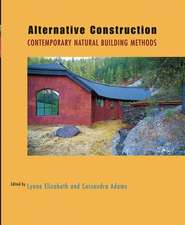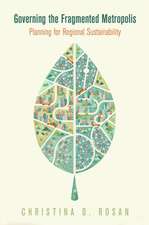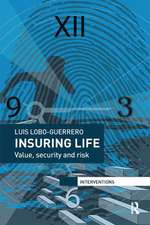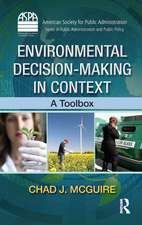What We See – Advancing the Observations of Jane Jacobs
Autor Stephen A. Goldsmith, Lynne Elizabethen Limba Engleză Hardback – 30 apr 2010
A timely revisitation of renowned urbanist-activist Jane Jacobs' lifework, What We See: Advancing the Observations of Jane Jacobs invites thirty pundits and practitioners across fields to refresh Jacobs' economic, social and urban planning theories for the present day. Combining personal and professional observations with meditations on Jacobs' insights, essayists bring their diverse experience to bear to sketch the blueprints for the living city.
The book models itself after Jacobs' collaborative approach to city and community building, asking community members and niche specialists to share their knowledge with a broader community, to work together toward a common goal of building the 21st century city.
The resulting collection of original essays expounds and expands Jacobs' ideas on the qualities of a vibrant, robust urban area. It offers the generalist, the activist, and the urban planner practical examples of the benefits of planning that encourages community participation, pedestrianism, diversity, environmental responsibility and self-sufficiency.
Bob Sirman, director of the Canada Council for the Arts, describes how built form should be an embodiment of a community narrative. Daniel Kemmis, former Mayor of Missoula, shares an imagined dialog with Jacobs,' discussing the delicate interconnection between cities and their surrounding rural areas. And Roberta Brandes Gratz—urban critic, author, and former head of Public Policy of the New York State Preservation League—asserts the importance of architectural preservation to environmentally sound urban planning practices.
What We See asks us all to join the conversation about next steps for shaping socially just, environmentally friendly, and economically prosperous urban communities.
The book models itself after Jacobs' collaborative approach to city and community building, asking community members and niche specialists to share their knowledge with a broader community, to work together toward a common goal of building the 21st century city.
The resulting collection of original essays expounds and expands Jacobs' ideas on the qualities of a vibrant, robust urban area. It offers the generalist, the activist, and the urban planner practical examples of the benefits of planning that encourages community participation, pedestrianism, diversity, environmental responsibility and self-sufficiency.
Bob Sirman, director of the Canada Council for the Arts, describes how built form should be an embodiment of a community narrative. Daniel Kemmis, former Mayor of Missoula, shares an imagined dialog with Jacobs,' discussing the delicate interconnection between cities and their surrounding rural areas. And Roberta Brandes Gratz—urban critic, author, and former head of Public Policy of the New York State Preservation League—asserts the importance of architectural preservation to environmentally sound urban planning practices.
What We See asks us all to join the conversation about next steps for shaping socially just, environmentally friendly, and economically prosperous urban communities.
Preț: 191.69 lei
Nou
Puncte Express: 288
Preț estimativ în valută:
36.70€ • 37.74$ • 30.44£
36.70€ • 37.74$ • 30.44£
Carte tipărită la comandă
Livrare economică 18 februarie-04 martie
Preluare comenzi: 021 569.72.76
Specificații
ISBN-13: 9780981559315
ISBN-10: 098155931X
Pagini: 354
Ilustrații: 2 B&W illustrations
Dimensiuni: 142 x 217 x 29 mm
Greutate: 0.61 kg
Editura: MI – New York University
ISBN-10: 098155931X
Pagini: 354
Ilustrații: 2 B&W illustrations
Dimensiuni: 142 x 217 x 29 mm
Greutate: 0.61 kg
Editura: MI – New York University
Recenzii
Advance Praise for What We See: Advancing the Observations of Jane Jacobs:
“I had never understood quite so clearly the effective power of Jane Jacobs’ writing… That if you take the time to look, to really observe, then you see what is happening and with the clarity of that vision you can act to save neighborhoods.”
—Nancy Milford, scholar, lecturer, and author of Zelda and Savage Beauty: The Life of Edna St. Vincent Millay
“Just in its title, What We See telegraphs the most important point Jane Jacobs ever made—don’t go into a city environment with preset notions of how things are supposed to work; instead, enter the space with as open a mind as you can muster and seek to observe how things actually work. What We See is a report … to tell Jane what we learned and how it has changed our cities and our lives.”
—Keith Bartholomew, Assistant Professor, College of Architecture and Planning, University of Utah, and coauthor, Growing Cooler: The Evidence on Urban Development and Climate Change
Reviews for What We See
"Some people set the pace for the future of advancing thought. What We See: Advancing the Observations of Jane Jacobs is a collection of essays dedicated to the thoughts and ideas of Jane Jacobs who through her work set much of the foundation for modern city planning, the idea of turning a city into a more perfect place to work and live. With ideas on encouraging prosperity, working with people, the right level of complexity, and more, What We See is a must for anyone wants to understand the forwarding thoughts surrounding city planning."
—Midwest Book Review
"What We See reaches beyond the platitudes about Jacobs' work. It features stories of her ideals played out in specific places and spaces by the people she has inspired and those who share an affinity with the spirit (and not just the letter) of her work... Jacobs has, deservedly, become the "patron saint" of progressive planning--anointed, revered, almost untouchable. Celebratory and reflective, What We See revels in Jacobs' godlike status while trying to bring a sense of realness to an intellectual celebrity...read alongside Jacobs' works, this book points towards a contextualization and deeper understanding of her legacy, in planning and fields beyond."
—Anusha Venkataraman, Progressive Planning
"The stories contained within the pages of What We See allow us to not only examine how our cities and neighborhoods are developing and changing, but the actions of the authors provide the reader with the inspiration to begin to make a difference in their own neighborhood, city, region and life. I would challenge anyone to read this book and not feel the burning desire to initiate positive change within their own neighborhood, community or city."
—Michael Ouchakof, enVisionGreen
"I encourage anyone who is interested in our cities and economies, how they work and how they can be vibrant and flourishing to read this book. I regret that I couldn't choose from the essays which illustrations or quotes or insights to highlight in a single review, there is just too much quality."
—Hazel Ashton, Village Connections
"The idea for What We See originated with the Jacobs-oriented Center for the Living City as a celebration honoring Jacobs, but the book took on a different form under Elizabeth's guidance. "I thought Jane would not have wanted a book about her," Elizabeth says, noting that two histories centering on her and a biography have recently been published. “Instead, we invited people from diverse fields to write their own ideas about how things work and describe the systems they see operating now and into the future.""
—Suzanne Mantell, Publisher's Weekly
"Fascinating though these projects are, What We See cannot be breezed through. At times, the collection is weighed down with policy. Some readers might find the prose too dependent on jargon. And most of the essays assume the reader's familiarity with Jacobs’s books and biography. Still, if What We See requires, at times, a professional’s duty-bound doggedness, it rewards the general reader’s generosity. The best selections inspire a kind of covetousness, as they present projects or politics you might want for your own city, for your own family to use and enjoy."
—Allyn West, Cite Magazine
"It is a new, entrepreneurial, 21st-century outlook. Indeed, the true message of What We See is that we have a fresh generation of urban thought leaders who have learned from Jane Jacobs, but are intelligent, passionate, and innovative enough to develop their own ideas, messages, and strategies for action."
—Greg Heller, Urban Direction
"With that in mind, the book is an important one because while the ideas of Jane Jacobs have appeal for many people, in the end they are largely discarded in the interest of practicality and control. But as Sanford Ikeda reminds us in What We See, the city has no purpose or end in itself. Great cities enable the better part of its inhabitants to be free to pursue their own diverse interests with the maximum likelihood of success."
—Eric Miller, The New Colonist
"The ultimate strength of gathering and showcasing such a diverse collection of writings is that everyone is bound to find a number of essays that resonate with them, and at least one that inspires them."
—Lisa Brideau, re:place Magazine
"The essays in What We See remind us that cities are inefficient, but in a good, necessary way, that they exist to allow inhabitants to pursue a wide range of dreams and goals, that they are complex and can be seemingly poised on the edge of chaos between the yin and yang of "I" the individual and "We" the body of citizens."
—April Streeter, Treehugger
“I had never understood quite so clearly the effective power of Jane Jacobs’ writing… That if you take the time to look, to really observe, then you see what is happening and with the clarity of that vision you can act to save neighborhoods.”
—Nancy Milford, scholar, lecturer, and author of Zelda and Savage Beauty: The Life of Edna St. Vincent Millay
“Just in its title, What We See telegraphs the most important point Jane Jacobs ever made—don’t go into a city environment with preset notions of how things are supposed to work; instead, enter the space with as open a mind as you can muster and seek to observe how things actually work. What We See is a report … to tell Jane what we learned and how it has changed our cities and our lives.”
—Keith Bartholomew, Assistant Professor, College of Architecture and Planning, University of Utah, and coauthor, Growing Cooler: The Evidence on Urban Development and Climate Change
Reviews for What We See
"Some people set the pace for the future of advancing thought. What We See: Advancing the Observations of Jane Jacobs is a collection of essays dedicated to the thoughts and ideas of Jane Jacobs who through her work set much of the foundation for modern city planning, the idea of turning a city into a more perfect place to work and live. With ideas on encouraging prosperity, working with people, the right level of complexity, and more, What We See is a must for anyone wants to understand the forwarding thoughts surrounding city planning."
—Midwest Book Review
"What We See reaches beyond the platitudes about Jacobs' work. It features stories of her ideals played out in specific places and spaces by the people she has inspired and those who share an affinity with the spirit (and not just the letter) of her work... Jacobs has, deservedly, become the "patron saint" of progressive planning--anointed, revered, almost untouchable. Celebratory and reflective, What We See revels in Jacobs' godlike status while trying to bring a sense of realness to an intellectual celebrity...read alongside Jacobs' works, this book points towards a contextualization and deeper understanding of her legacy, in planning and fields beyond."
—Anusha Venkataraman, Progressive Planning
"The stories contained within the pages of What We See allow us to not only examine how our cities and neighborhoods are developing and changing, but the actions of the authors provide the reader with the inspiration to begin to make a difference in their own neighborhood, city, region and life. I would challenge anyone to read this book and not feel the burning desire to initiate positive change within their own neighborhood, community or city."
—Michael Ouchakof, enVisionGreen
"I encourage anyone who is interested in our cities and economies, how they work and how they can be vibrant and flourishing to read this book. I regret that I couldn't choose from the essays which illustrations or quotes or insights to highlight in a single review, there is just too much quality."
—Hazel Ashton, Village Connections
"The idea for What We See originated with the Jacobs-oriented Center for the Living City as a celebration honoring Jacobs, but the book took on a different form under Elizabeth's guidance. "I thought Jane would not have wanted a book about her," Elizabeth says, noting that two histories centering on her and a biography have recently been published. “Instead, we invited people from diverse fields to write their own ideas about how things work and describe the systems they see operating now and into the future.""
—Suzanne Mantell, Publisher's Weekly
"Fascinating though these projects are, What We See cannot be breezed through. At times, the collection is weighed down with policy. Some readers might find the prose too dependent on jargon. And most of the essays assume the reader's familiarity with Jacobs’s books and biography. Still, if What We See requires, at times, a professional’s duty-bound doggedness, it rewards the general reader’s generosity. The best selections inspire a kind of covetousness, as they present projects or politics you might want for your own city, for your own family to use and enjoy."
—Allyn West, Cite Magazine
"It is a new, entrepreneurial, 21st-century outlook. Indeed, the true message of What We See is that we have a fresh generation of urban thought leaders who have learned from Jane Jacobs, but are intelligent, passionate, and innovative enough to develop their own ideas, messages, and strategies for action."
—Greg Heller, Urban Direction
"With that in mind, the book is an important one because while the ideas of Jane Jacobs have appeal for many people, in the end they are largely discarded in the interest of practicality and control. But as Sanford Ikeda reminds us in What We See, the city has no purpose or end in itself. Great cities enable the better part of its inhabitants to be free to pursue their own diverse interests with the maximum likelihood of success."
—Eric Miller, The New Colonist
"The ultimate strength of gathering and showcasing such a diverse collection of writings is that everyone is bound to find a number of essays that resonate with them, and at least one that inspires them."
—Lisa Brideau, re:place Magazine
"The essays in What We See remind us that cities are inefficient, but in a good, necessary way, that they exist to allow inhabitants to pursue a wide range of dreams and goals, that they are complex and can be seemingly poised on the edge of chaos between the yin and yang of "I" the individual and "We" the body of citizens."
—April Streeter, Treehugger
Notă biografică
Lynne Elizabeth is founder of New Village Press and past President of Architects/ Designers/ Planners for Social Responsibility (ADPSR). She is co-editor of Works of Heart: Building Village through the Arts (2006) and Alternative Construction: Contemporary Natural Building Methods (2000, 2005), and a contributing author for Ecovillage Living (2002) and Sustainable Architecture White Papers (2000). Ms. Elizabeth previously produced periodicals on sustainable community development, New Village Journal and Earthword Journal. She founded the former Eos Institute for the Study of Sustainable Living and has served since 1998 as committee member and former juror for the Berkeley Prize for Architectural Design Excellence.
Stephen Goldsmith has worked as an artist, educator, and activist for affordable housing and community development. He was the founder and Director of Artspace in Salt Lake City and led the development of live/work, mixed-use space through the adaptive reuse of historic buildings. He was a Loeb Fellow at the Harvard Design School, and served as planning director in Salt Lake City before becoming Director of the Enterprise Rose Architectural Fellowship. He is Director of the Center for the Living City and Associate Professor at the College of Architecture and Planning at the University of Utah.
ADDITIONAL CONTRIBUTORS INCLUDE: Janine Benyus, Hillary Brown, Robert Cowan, David Crombie, Pierre Desrochers, Samuli Leppälä, Matias Sendoa Echanove, Nan Ellin, Mindy Thompson Fullilove, Jan Gehl, Arlene Goldbard, Roberta Brandes Gratz, Ken Greenberg, Nabeel Hamdi, Chester Hartman, Sanford (Sandy) Ikeda, Allan Jacobs, Daniel Kemmis, Jaime Lerner, Elizabeth Macdonald, Clare Cooper Marcus, Richard Register, Mary Rowe, Janette Sadik-Khan, Saskia Sassen, Ron Shiffman, Robert Sirman, Rahul Srivastava, James Stockard, Ray Suarez, Deanne Taylor, Alexie M. Torres-Fleming, Susan Witt, and Peter Zlonicky.
Stephen Goldsmith has worked as an artist, educator, and activist for affordable housing and community development. He was the founder and Director of Artspace in Salt Lake City and led the development of live/work, mixed-use space through the adaptive reuse of historic buildings. He was a Loeb Fellow at the Harvard Design School, and served as planning director in Salt Lake City before becoming Director of the Enterprise Rose Architectural Fellowship. He is Director of the Center for the Living City and Associate Professor at the College of Architecture and Planning at the University of Utah.
ADDITIONAL CONTRIBUTORS INCLUDE: Janine Benyus, Hillary Brown, Robert Cowan, David Crombie, Pierre Desrochers, Samuli Leppälä, Matias Sendoa Echanove, Nan Ellin, Mindy Thompson Fullilove, Jan Gehl, Arlene Goldbard, Roberta Brandes Gratz, Ken Greenberg, Nabeel Hamdi, Chester Hartman, Sanford (Sandy) Ikeda, Allan Jacobs, Daniel Kemmis, Jaime Lerner, Elizabeth Macdonald, Clare Cooper Marcus, Richard Register, Mary Rowe, Janette Sadik-Khan, Saskia Sassen, Ron Shiffman, Robert Sirman, Rahul Srivastava, James Stockard, Ray Suarez, Deanne Taylor, Alexie M. Torres-Fleming, Susan Witt, and Peter Zlonicky.
Textul de pe ultima copertă
Thirty-five contemporary thinkers offer insight into the workings of vibrant, ecological, equitable communities and their economies.
Advance Praise for What We See
"It's as if Jane Jacobs' bright eye hadn't dimmed... In the hands of this book's essay writers, new thoughts sprout, all as true to Jane's spirit and inventive urbanity as the gardens (intellectual and physical) she cultivated in her lifetime."
--Neal Peirce, journalist and Chair, The Citistates Group; author, Boundary Crossers
"In this book are the testimonials of 'Jane's children'... building on what she began back in the '60s. It's taken a long time, but it's happening."
--David Byrne, musician, artist and author, Bicycle Diaries
"A delicious international and interdisciplinary banquet of offerings to honor the passionate and multifaceted work of our beloved urbanist, Jane Jacobs."
--Wendy Sarkissian, author, Kitchen Table Sustainability and Creative Community Planning
"How can one resist cheering on this urban original?... We see how Jane Jacobs and our neighborhoods live on through her ideas."
--Victor S. Navasky, Publisher Emeritus, The Nation, and author, A Matter of Opinion
"The reflections on this remarkable woman, and the still-unfolding project of city-building today, are a joy to read."
--Anthony Flint, author, Wrestling with Moses
"The essayists in What We See have built on those essential footholds that people who have never heard of Jane Jacobs will benefit them for decades."
--Majora Carter, founder, Sustainable South Bronx, and winner, Rachel Carson Award
"A moving and enlightening tribute to the ideas and methods of Jane Jacobs... that will inspire others to observe closely, contemplate broadly, and engage civically."
--Glenna Lang, co-author, Genius of Common Sense
"There is no better starting place for re-evaluating tomorrow's complex cities than this book, which is full of the wisdom and insight Jane Jacobs so astutely taught us... Hallelujah! Hallelujah!"
--Fred Kent, President, Project for Public Spaces
Descriere
Leading thinkers offer fresh insight into the workings of vibrant, ecological, equitable communities and their economies.














